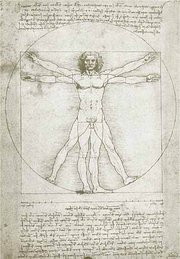Vitruvian Man
|
|
The Vitruvian Man is a famous drawing with accompanying notes by Leonardo da Vinci made around the year 1490 in one of his journals. It depicts a naked male figure in two superimposed positions with his arms apart and simultaneously inscribed in a circle and square. The drawing and text are sometimes called the Canon of Proportions.
The drawing is in pen, ink, and watercolor over metalpoint, and measures 34.3 x 24.5 cm. It is currently part of the collection of the Gallerie dell'Accademia in Venice.
According to Leonardo's notes in the accompanying text, which are mirror writing, it was made as a study of the proportions of the (male) human body as described in a treatise by the Ancient Roman architect Vitruvius, who wrote that in the human body:
- a palm is the width of four fingers
- a foot is the width of four palms
- a cubit is the width of six palms
- a man's height is four cubits (and thus 24 palms)
- a pace is four cubits
- the length of a man's outspread arms is equal to his height
- the distance from the hairline to the bottom of the chin is one-tenth of a man's height
- the distance from the top of the head to the bottom of the chin is one-eighth of a man's height
- the distance from the hairline to the top of the breast is one-seventh of a man's height
- the distance from the top of the head to the nipples is one-fourth of a man's height
- the maximum width of the shoulders is one-fourth of a man's height
- the distance from the elbow to the tip of the hand is one-fifth of a man's height
- the distance from the elbow to the armpit is one-eight of a man's height
- the length of the hand is one-tenth of a man's height
- the distance from the bottom of the chin to the nose is one-third of the length of the face
- the distance from the hairline to the eyebrows is one-third of the length of the face
- the length of the ear is one-third of the length of the face
Leonardo is clearly illustrating Vitruvius De Architectura 3.1.3 which reads:
- The navel is naturally placed in the centre of the human body, and, if in a man lying with his face upward, and his hands and feet extended, from his navel as the centre, a circle be described, it will touch his fingers and toes. It is not alone by a circle, that the human body is thus circumscribed, as may be seen by placing it within a square. For measuring from the feet to the crown of the head, and then across the arms fully extended, we find the latter measure equal to the former; so that lines at right angles to each other, enclosing the figure, will form a square.
The rediscovery of the mathematical proportions of the human body in the 15th century by Leonardo and others is considered one of the great achievements leading to the Italian Renaissance. Note that Leonardo's drawing combines a careful reading of the ancient text, combined with his own observation of actual human bodies. In drawing the circle and square he correctly observes that the square cannot have the same center as the circle, the navel, but is somewhat lower in the anatomy. This adjustment is the innovative part of Leonardo's drawing and what distinguishes it from earlier illustrations.
The drawing itself is often used as an implied symbol of the essential symmetry of the human body, and by extension, to the universe as a whole.
It may be noticed by examining the drawing that the combination of arm and leg positions actually creates sixteen different poses. The pose with the arms straight out and the feet together is seen to be inscribed in the superimposed square. On the other hand, the "spread-eagle" pose is seen to be inscribed in the superimposed circle. This illustrates the principle that in the shift between the two poses, the apparent center of the figure seems to move, but in reality, the navel of the figure, which is the true center of gravity, remains motionless.
See also
- The Modulor of Le Corbusier
- Body proportions
External links
- Gallerie dell'Academia website (http://www.gallerieaccademia.org/)
- Willamette University site on Vitruvian man (http://www.willamette.edu/cla/exsci/info/history/vitruvian.htm)
- Stanford University site on Vitruvian man (http://leonardodavinci.stanford.edu/submissions/clabaugh/history/leonardo.html)
- Mathematics of the Vitruvian man (http://www.aiwaz.net/Leonardo/vitruvianman/index.html)es:Hombre de Vitruvio
he:האדם הויטרובי ru:Витрувианский человек pt:Homem vitruviano

